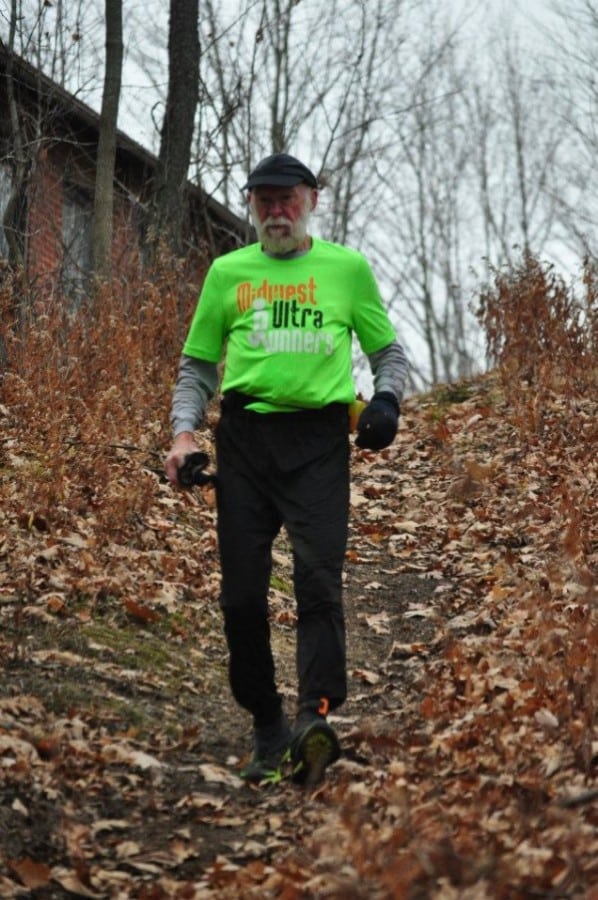Dick Canterbury walks into the coffee shop and sets a large black binder on the table. Inside is a list, spreading over numerous worn-out pages, covered in fading pencil lead. The entries are chronologically scribbled:
- November 1988: Columbus Marathon 3:26
- June 2003: Western States 100 29:28
- January 24, 2014: Liberty Bible Church, nine miles
- And the latest race entry: February 2014: Rocky Raccoon 100, 27:46

Dick runs during the Midwest Grand Slam last year. Photo courtesy of Dick Canterbury.
At 66 years old, Dick Canterbury is no different than he was 26 years ago when he first started running except that he has a few more race shirts to don while around town.
In 1988, when he was 40 years old, Dick was introduced to the sport of running while living in Columbus, Ohio, where he was raised. In 1994, his family, now with the addition of two children and his wife, Becky, moved to their present home in Chesterton, Indiana, where Dick found himself entering into the ultra world.
Dick completed his first ultramarathon in 1996 at the Ice Age Trail 50 Mile in Wisconsin when he was 48 years old. Today, 114 marathons and over 66 ultras, 26 of which have been 100s, are evidenced in that thick black book, along with every training run, shoe type, and location. It is the running chronicle of Dick Canterbury, and it is not even close to being done.
In the small town of Chesterton, Dick is well known to all who lace up their running shoes every weekend. To many, he is like the father figure for northwest Indiana running, the one to scurry to for advice on training or insights on a certain race. But to Dick, he sees himself simply as the only one in the area who has remained in the sport. “I was the youngster in the ultra world, the baby, when I moved here,” he says, chuckling. “Now, I am the only individual continuing to run ultras from the group I started with.” When first arriving to the area, Dick ran with some of the local runners, including author and Runner’s World-acclaimed writer, Hal Higdon, who introduced him to the trails of the Indiana Dunes National Lakeshore.
Misty Chandos, a fellow ultrarunner, said Dick works with and mentors for the No Boundaries Beginner program through the Fleet Feet store in Schererville, Indiana, which is how she met him. “I was looking for someone who knows the Dunes well to lead a group of runners on weekend runs. He is quiet, but is so knowledgeable. He is so inspiring to people, and he really wants to help those who are just beginning to run.” According to Chandos, Dick was running ultramarathons before they were the craze they are now, crediting Dick with the reason why ultras have become so popular in the area.
And it’s true. Every weekend, a license plate stamped with the words ‘Runs 100’ slides into the parking lot filled with several other cars with running-related decals. Dick, a member of the northwest Indiana running group, the Midwest Ultra Runners, stands at the edge of the trail along with various members of the five other running groups of the area. Adjusting shoelaces and fixing watches, Dick stands out with white hair poking out of his black, cotton hat, a snow-white beard, an age difference of about 30 or 40 years, and a race resume long enough to cover the six-mile trail the runners are about to embark on.

Dick at the 2013 Burning River 100. He had his age, 65, printed on the sleeve of his Midwest Ultra Runners shirt and wore it for all five 100s of the Midwest Grand Slam. Photo courtesy of Dick Canterbury.
Dick ran his first 100-mile race at the Mohican 100 Mile race in Ohio in 1999. “At the finish line, I said I was never going to do that again, and probably before I got home, I was thinking about what I needed to do to improve for the next one.” Since then, Dick has remained true to the Mohican race, finishing 12 of them, earning himself a special belt buckle and a free entry for life. Yet, that does not beat his 14–time return to his favorite race, the Ice Age 50.
Obviously, repetition does not hinder Dick, who devotedly competes in Midwest-located races. In 2013, Dick completed his first attempt of the Midwest Grand Slam of Ultrarunning, which includes the Kettle Moraine 100 Mile in Wisconsin in June, the Mohican 100 two weeks later, Burning River 100 Mile Endurance Run in Ohio in July, and the Hallucination 100-Mile in Michigan in September. “There were 14 finishers,” he said. “When you see the same people at the same events, it encourages you to keep going. It is like a little family get-together each time.”
According to Dick, the Midwest Grand Slam is easier than the commonly known Grand Slam Of Ultrarunning out West due to its flatter race terrains and a less competitive entry process into the races. Yet, Dick ‘adjusted’ the 2013 series to suit his liking. New to 2013 Slam was the inaugural Indiana Trail 100 in Albion, Indiana. The April race was added into the series, but was not a required event to complete the Slam.
“I completed the Indiana Trail 100, so I completed what is known as grand slamming. There were only four of us who ran it out of the 14 who finished the Slam.”
Though it came with its struggles, travel, time spent away from his family, and plenty of money spent on entry fees, Dick regards the Slam experience as his “most measured achievement he has ever accomplished.”
“It sounded like a challenge and felt that if I didn’t do it when I was 65, I never would. So many things went right. No injuries, illnesses, or deaths in the family that kept me from recovering.”
“One of the most amazing things I find about the human brain is how fast it forgets about pain and discomfort,” says Dick.
“He is one of the toughest people mentally that I have ever met,” says Norm Williams, a friend and frequent pacer of Dick’s. “Somebody once told Dick to never get old, and that seems to be his outlook. He’s very focused when he races, no matter what the conditions or terrain are. He is relaxed and stays steadily focused.”
Well, most of the time. Like most ultrarunners staggering through the dark depths of the last 20 miles of race, ‘focus’ is a struggle. “Last year during the Kettle Moraine, he walked into a tree,” Williams remembers. “After hitting it, Dick said, ‘Norm, I saw the tree but I walked right into it!’”
Williams and Dick have spent many long hours on the trails together, discussing everything from T.V. shows to Dick’s latest update on his gun club. During a race, aid stations are an out-and-go process, and walking is strongly relied upon for finishing a race. Dick will typically run hard the first 50 to 60 miles of a race, and will then incorporate a walk/run strategy, or sometimes just walking, the rest of the race into the finish line. “I am not running fast,” Dick explains, finally releasing the secret to his ultra success. “Time is not important; speed is not important; I am just accomplishing the race.”

Dick at the Indiana Trail 100. Photo: Indiana Trail 100
However, when placed in a marathon, Dick’s ageless legs still seek speed. Before, after, and in between the Midwest Slam, he cruised through two 50ks, another Ice Age race, and a 24-hour run held in northwest Indiana. And after the last Midwest Slam event, Dick participated in an additional five marathons concluding the year with 3,200 miles and a total of 19 races overall.
Of those, Dick was a returning pacer for the Chicago Marathon, along with participating in the inaugural Dawn of the Dunes Marathon in Gary, Indiana, where he finished in a time of 3:34:29, a time well below his age standard for Boston qualification. Though not a fan of 5ks and 10ks, in which he could count on one hand the number of times he’s raced them, Dick looks upon marathon racing with one more goal in mind.
In September, after the Midwest Grand Slam, Dick was adamant about not repeating the daunting event. He was thinking about taking a break from ultras for awhile to see what he could do in a marathon, thinking about attempting to lower his just-raced, 3:34 time, and coming as close as possible to his 1996 personal record of 3:03 in future marathons. But, of course, the lure of the trails could not be ignored.
Although each one, the Slam and fast marathon training, is a highly crazy and difficult endeavor, a new challenge was already forming in Dick’s mind that surpassed them both.
On February 1, Dick ran his first ultra of the year, the Rocky Raccoon 100 Mile and initiated the start of his 2014 plan. “I signed up for it [the Midwest Grand Slam] at the end of last year,” Dick recounts. “And I thought, Well, five 100s at 65 years old, that’s pretty good. So I decided to enter at 66 years old and try six.”

Dick stops to fill up at a Fat Ass 50k aid station in April 2013. Photo: Indiana Trail 100.
How does he do it? It is a question asked by many, but to Dick, the answer is simple. “I like to challenge myself. That is why I keep pushing myself to do ultras. I just enjoy them and want to continue to do them as long as I can.” Dick runs for every reason in the book, yet pinpoints it to his goal of inspiring and encouraging other runners, emitting some of that father-like personality.
“I like to see if I can inspire people, and knowing that I have been an encouragement to so many in this area has meant a lot to me. Hopefully, some younger runners will see me running and say, ‘If that old man can go out and do it, then so can I!’”
Call for Comments (from Meghan)
Okay Midwest trail runners, we’re eager to hear your Dick Canterbury stories. Have you met or run with Dick at a running event or race? What did you learn about this Indianan ultrarunner who keeps running and running?
